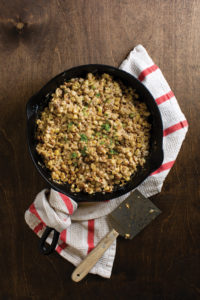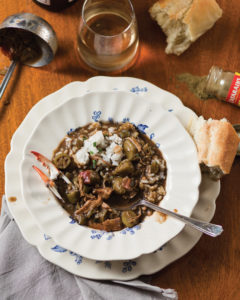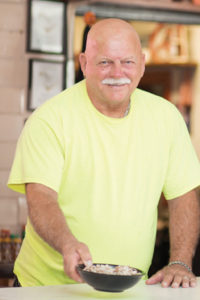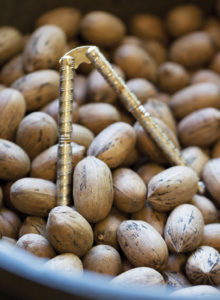Some things change in today’s day and age like flashes of summer lightning. Others move at the pace of a growing live oak — slow and steady, changing very little through the decades. Gulf Coast food is one of those constants. Many of the dishes, ingredients and traditions that our forebears enjoyed are just as commonly found on today’s tables.
This culinary vernacular began, and continues, in part due to the local climate and the nature of what grows in these parts. Local fields still turn out many of the same fruits, vegetables and nuts that subsistence farmers were growing a century ago because, well, that’s what grows best here.
At the same time, our food culture retains strong influences from our ancestors’ roots and the roads they traveled to get here. Native Americans cultivated corn, African slaves brought peas, okra and peanuts, and early trade routes through the Caribbean inflected jolts of spice and stirred the pot of Creole goodness.
Our modern local cooking is certainly built upon these strong historical foundations, but there are a number of restaurants and recipes from more recent times that have made their way into our diets and homes for the long haul, as well. They are as much a part of eating in Mobile, Alabama, as gumbo and fried oysters. Here, MB breaks down the list of dishes you have to know and love to call yourself a true Mobilian.
The dinner bell is ringing and these foods are here to stay.
BOILED CRABS

The Chesapeake Bay might have made steamed crabs nationally known, but in these parts, we boil them. Alive. Squeamish hearts need not apply to assist in this endeavor, although you will certainly want to be there when it’s time to eat. Most folks dump the boiled crabs right on a newspaper-covered table to crack and eat right away. Others, with more self control, cook the crabs, pick all the meat, and save it for recipes like crab pie or crab salad or creamed crab. Any way that’s preferred, the basic recipe for boiling stays the same.
Boaty Campbell, a lifelong resident of the shores of Mobile Bay, crabbed commercially for 30 years to supplement his income. He built his boat, caught his bait and designed his own traps. “Not all traps are created equal — some fish better than others,” he tells us. But these days he has downsized from 200 traps to just five, positioned perfectly along the length of his wharf in Point Clear. While crabs are most plentiful during the summer months, someone who knows what he’s doing — like Boaty — can find a catch year-round by knowing where to look. Fresh fish carcasses make the best bait and attract all sorts of aquatic species, many of which often get stuck in the trap along with the crabs. That’s part of the fun in pulling the rope and raising the trap — you never know what you’re going to get!
How To Boil Live Crabs
Method by Boaty Campbell
1. Always start with live crabs. Wash the crabs in a basket and use tongs to transfer them to a big pot.
2. Add enough cold water to cover the crabs. It’s best to use cold water because the shock of adding live crabs to boiling water causes them to lose their claws, making them less presentable at the table.
3. Add 1/2 cup rock salt per dozen crabs.
4. Bring the crabs to a boil and cook for 12 minutes.
5. Remove crabs from the boiling water immediately and spread them on a table covered with newspaper.
6. While still hot, generously sprinkle the crabs with Old Bay Seasoning. The seasoning finds its way onto the crabmeat as you enjoy cracking, cutting and eating them.
SWEET CORN
Nothing says summer in the Deep South like sweet white corn bought by the bushel on the side of the road. Why so much hoopla over corn? White corn is almost never sold in grocery stores due to its pitiful shelf life, so when you find it for sale, you buy it. You know it was grown locally because a product like that cannot be shipped across country easily. Silver Queen has been a favorite variety for decades. Also popular are newer, sturdier hybrids such as Silver King and Devotion that can stand up to the area’s strong winds and persistent pests. Though not genetically modified, these big ears of milky sweetness have been selectively bred over decades to be delicious and strong and, well, just about perfect.
Baldwin County farmers start planting in February so the corn can be ready by your Memorial Day trip to the beaches. They plant fields every two weeks afterward so the corn can last through the Fourth of July. A fall planting is possible, making the white corn available now! But risk-averse farmers rarely take a gamble on this expensive crop that could get pummeled in late summer rainstorms. Krupinski Farm in Foley planted a fall crop of Devotion this year, and if you’re lucky and the weather holds, there might be a few ears left for sale by the time this issue comes out!
Skillet Sweet Corn Recipe

10 ears Silver King corn
4 tablespoons unsalted butter
1 teaspoon kosher salt
1/4 teaspoon freshly ground black pepper
1. Husk the corn and remove the silks. Hold each ear firmly over a large bowl and slice down the sides of the corn with a sharp knife, removing the kernels as close to the cob as possible. The bowl will help prevent the kernels from flying around the room.
2. Milk each ear of corn, see below, into the bowl and then discard the empty cob.
3. Heat a large cast-iron skillet over medium heat and add butter to melt. Add the corn and saute uncovered for 10 minutes, occasionally scraping the bottom of the pan with a metal spatula to prevent corn from burning. Season with salt and pepper to taste, and serve warm.
How to Milk Corn
Once you remove the long strips of crisp uncooked kernels, don’t even think about tossing the cobs! For extra sweet and creamy skillet corn, milk each cob straight into the pan. Hold the cob with one hand, and use the other hand to drag the back of a knife firmly down the cob toward the pan. All the starchy sweet juice will dribble (and often splatter) out and add an extra layer of deliciousness to your dish.
SEAFOOD GUMBO

There is little reason to waste valuable words on gumbo — everyone agrees it is a kitchen and restaurant menu staple in these parts. For anyone who might be new to town, though, here are the basics for a good creole stew: a very dark roux is stirred in a cast-iron pot and then finished with okra, tomatoes, onions, bell pepper and spices,
followed by embarrassing amounts of local blue crab and shrimp. A dollop of white rice should be more condiment than filler, and a sprinkling of filé (ground sassafras leaves) is optional. Food historians claim gumbo should have either okra or filé, but never both, as the two ingredients serve the same thickening purpose. We say garnish as you like.
DEW DROP HOT DOG

In a world where culinary fads change as quickly as the weather forecast along the Gulf Coast, the Dew Drop — and its food — have remained unchanged over the decades.
The little eatery that was originally founded in 1924 at Ann near Government Street moved to its current location in 1937 and got its groovy midcentury facelift in 1967. That was the last time anything major changed in those parts. The waitstaff stays constant, the menu never varies and the ingredients on those killer hot dogs are the same as they’ve always been, right down to the bright red weenie. Sure, you could order the fried seafood, a burger or a country vegetable plate, but why mess with perfection? A pork and beef wiener topped with homemade chili, sauerkraut, mustard, ketchup and a pickle slice is Mobile’s favorite way to eat a dog. Regulars have their favorite booth and their favorite waitress, and they don’t even think of asking to see a menu. Just bring your own Tums.
CHINA DOLL RICE

More than 80 years ago, local grocery store shelves looked very different from what we see today. There was very little packaged and processed foods, and giant bins of rice were sold one scoop at a time and bagged up to order. In 1936, a local rice distributor realized that individually packaged rice would be a hit if they could just get the grocers on board. An employee contest picked the name China Doll for a $50 prize and the rest is history. Mobilian Barbara Colle owned the company until her death in 1990. Harris V. Morrissette bought the company in 2005 and now runs it along with flour and cornmeal brand Dixie Lilly, another Southern staple from the early 1930s, although not of Mobile origin. China Doll’s “grown in the USA” rice is the one to serve on local tables.
POLLMAN’S

As Pollman’s Bake Shop celebrates its 100th anniversary this year, there can be little disagreement about the mark it has made on Mobile. A company doesn’t last that long without becoming an integral part of people’s lives. The interesting thing, however, is that Mobilians simply cannot agree on what is the No. 1 Pollman’s eat! Is it the colorful iced sugar cookies? The delicate petit fours? The simple yet hearty roast beef and turkey po’boys? Everyone has their favorite, but Rose Pollman, married to the third-generation baker, says that the top Pollman’s treat has to be the chocolate doberge cake. The recipes for these decadent layers of cake, filling and ganache came over with the family from New Orleans in 1918, along with king cakes and po’boys, they claim, and have been on the menu ever since. That’s not to say that they sell more doberge cakes than anything else. The iced sugar cookies sell in the 15,000 per year range, according to estimates, and other baked specialties aren’t far behind. But a doberge for your birthday is a local tradition that can’t be beat.
WEST INDIES SALAD

In 1947, Bill Bayley opened a one-room restaurant on Dauphin Island Parkway serving fresh local seafood. In no time, the little place expanded to seat more than 200 people. They claimed to have cleaned more than 150 pounds of flounder a week for eager customers and to have invented fried crab claws, to boot! But the West Indies Salad is what made Bayley’s famous. Bill Bayley Jr. remembers that with such a big dining room, it took a while for patrons to get their food. That’s where the West Indies salad came into play. A bowl of marinated crabmeat and a basket of saltines was all it took to keep customers happy while they waited on the main attractions. Although it isn’t clear where Bayley came up with the recipe, family members trace the origins to two places — a similar lobster salad he made in the Caribbean during his time as a merchant seaman, and his love for cucumber and onions marinated in oil and ice water. Put those together, with a south Alabama twist, and you have the original West Indies Salad.
Bayley’s West Indies Salad
Printed in the “Recipe Jubilee” cookbook from the Junior League of Mobile
1 medium sweet onion, finely chopped
1 pound claw crabmeat
1/2 teaspoon salt
1/2 teaspoon pepper
1/2 cup vegetable oil
1/2 cup cold water
6 tablespoons cider vinegar
saltine crackers for serving
1. Add half the chopped onion to the bottom of a large bowl. Pick through crabmeat for shells and add to the bowl, and then top with remaining chopped onion.
2. In a separate small bowl, combine remaining ingredients and stir. Pour over the top of the crab and onion mixture and cover with plastic wrap.
3. Refrigerate several hours or overnight.
4. Toss gently and taste for seasoning, adding more if needed. Serve with a side of saltine crackers as an appetizer.
MAMIE’S FAMOUS CHEESE WAFERS

The perfect bite to serve with a cocktail, cheese straws or cheese cookies are a real Southern staple. The basic recipe is incredibly simple (flour, cheese, butter, baking soda, spices) and yet variations abound with slight adjustments in the kind of cheese, the temperature of the butter or the kick of spice. Even how they’re pressed or molded affects the crunch or crumble.
Mobilian Mary Byrd developed what some say is the perfect cheese cookie recipe and passed it down to her children and grandchildren. But it wasn’t until 2003 that her daughter, Barkley Shreve, decided to share the recipe with the world. Her sister had been prodding for months that it was a wonderful snack to keep unbaked and on-hand in case unexpected company should drop by. But making one recipe at a time is different than developing a commercial batch that can be marketed wholesale to grocery stores. Barkley worked for months to create a large-batch version of her mother’s cheese cookie recipe that would go on to become Mamie’s Famous Cheese Wafers. Now sold in stores nationwide, thanks in large part to the early support of The Fresh Market, kitchens everywhere can have a little taste of Mobile hospitality at the ready. Mamie’s can be found at groceries and specialty markets all over the Bay area and even online at Williams Sonoma. It’s slice and bake, done the Deep South way.
STUFFED FLOUNDER

There is no fish more Mobile Bay than the humble flounder. Lying quietly along the sandy bottom, he hopes no one notices him while he watches with two eyes on one side of his head. A genetic wonder! These members of the flatfish species conjure thoughts of jubilees and floundering in the shallows on hot summer nights. Surely there is no better way to eat them than stuffed with crabmeat and all the delicious trimmings.
Greek immigrant George Roussos had a long and accomplished career here in the Port City. He opened his first restaurant location on the Causeway, only to have it wiped out by Hurricane Frederic in 1979. Shortly afterward, he reopened at the well-known Fort Condé location and operated there for many years. The star of the menu was his stuffed flounder, along with other local seafood and Greek-inspired specialties. The restaurant became such a fixture of downtown Mobile that Mayor Mike Dow proclaimed July 7, 1998, “George J. Roussos’ Day” in honor of his 81st birthday.
His daughter, local caterer Georgia Roussos, shared her father’s recipe for the original stuffed flounder, with plenty of crabmeat and not too much stuffing to weigh down the flaky, tender fish.
Roussos’ Stuffed Flounder
3 ounces butter, plus more for basting
1 cup diced yellow onion
1/2 cup diced red bell pepper
1/2 cup diced green bell pepper
1/2 cup diced celery
1 tablespoon minced garlic
1 tablespoon chopped fresh thyme
1 dash cayenne pepper
1/2 pound claw meat (picked clean of shells)
1/2 pound lump crabmeat (picked clean of shells)
3/4 cup chopped green onion
1 1/2 cups crushed saltines
1 1/2 lemons, juiced
1 egg
1/2 cup grated Parmesan cheese
salt and pepper to taste
4 1-pound flounders (scaled, head and bones removed)
8 large shrimp, peeled
1 lemon
1. Preheat oven to 400 degrees. Melt butter in a medium saute pan, and add first 7 ingredients. Saute until translucent. Season with salt and pepper then set aside to cool.
2. Gently mix the 7 following ingredients into the sauteed vegetables.
3. Stuff each flounder with mixture and place on a foil-lined rimmed baking sheet. (This might require 2 sheet pans.) Garnish each fish with 2 shrimp and bake for 10 minutes. Open oven and baste fish with additional melted butter, and then cook for another 10 minutes.
4. Serve with a fresh squeeze of lemon.
PECANS AND PEANUTS

Mobilians have a long history of being completely nuts — Eugene Walter reminded us of that. But we come by it naturally, having produced pecans and peanuts (technically a legume) for centuries.
Alabama is the eighth-largest pecan producer in the country, according to Auburn University, producing 6.8 million pounds of nuts a year. Mobile and Baldwin counties are the hub of all of this growth.
And while Dothan produces more than 65 percent of all peanuts in the United States, Baldwin County is not too shabby, coming in as one of the top four producing counties in the state. Alabama has an overall annual harvest of more than 400 million pounds, according to the University of Alabama.
With all the research these days on healthy fats, fiber, protein and omegas found in nuts, we say you can overindulge and go completely — you know — nuts.
GEORGE MAJOR’S CHICKEN

Hines “George” Major worked for the Smith family and Smith Bakery from the late 1950s into the early 1970s, and became well known by barbecuing chicken over red oak at certain mystic society events. His barbecue sauce became legendary, especially after it was published in 1964 in the Junior League of Mobile cookbook, “Recipe Jubilee!”
One night as George was cooking, one of the mystic members, watching over his shoulder, kept making suggestions and asking questions: “doesn’t it need more so-and-so?” George — never a patient or easy man, by reputation — looked up and said “Boss, do you know the name of this sauce?” The member answered, “Sure! George Major’s barbecue sauce.” George looked at him and replied, “Well, my name is George Major!” He didn’t get any more suggestions that night.
The recipe, in all its perfection, can be found on the menu at Felix’s and other “member’s only” restaurants in the area.
George Major’s Barbecue Sauce for Chicken
Recipe from “Recipe Jubilee,” submitted by Mrs. Gillette Burton
2 sticks butter
2 lemons
2 onions
1 large bottle Worcestershire sauce
2 bottles A-1 Sauce
1. Melt butter in saucepan. Cut lemons in half and squeeze juice into melted butter. Cut onions into six slices, then add lemon rinds and onions to mixture. Simmer 20 minutes.
2. Add Worcestershire and A-1, simmering an additional five minutes. Use generously on chicken roasted on barbecue pit.
PUNTA CLARA PRALINES

Punta Clara Candy Kitchen has been a Point Clear fixture since Dorothy Brodbeck Pacey began selling her famous fig preserves and pralines, along with homemade cakes and other confections, in 1952 from a tiny kitchen in her backyard. It later made the move to her aunt Colleen Brodbeck’s 1897 Victorian home located 2 miles south of the Grand Hotel, where old family photos line the walls and you feel like you are stepping back in time. The pralines have always been sought after — Dorothy and her chemical engineer husband perfected the recipe and little has changed since then. By the time Dorothy passed away in 2008, her granddaughter Kim had taken over, and the candy kitchen now employs four generations of Paceys. The divinity is another old Southern Punta Clara favorite, with a mystifyingly delicious consistency, given our oppressive humidity. But then that’s why we leave candy making to the professionals.
OYSTER LOAF

Many argue about the birth of the humble, but oh-so-satisfying, oyster loaf, with New Orleans and San Francisco both making their case for the claim. The exact origins are unknown, and frankly, unimportant, as it is clear that Mobilians have been eating these delectable loaves at least 150 years. Some say the oyster loaf was first called a peacemaker, being the perfect bundle for an inebriated gent to carry home to his fed-up wife. The sandwiches later evolved into what we now call a po’boy, and any local menu that still offers a so-called oyster loaf is probably selling a po’boy in sheep’s clothing. But the name has history, and we fully support that. The recipe below from 1878 tells you exactly how to get it done.
The following recipes from come from “Gulf City Cookbook: Compiled by the Ladies of the St. Francis Street Methodist Episcopal Church, South, Mobile, Alabama, 1878.”
Fried Oysters
Select large oysters, drain and spread on a cloth to absorb all moisture. Beat well two or three eggs, and season them with pepper and salt. Roll some crackers, and dip the oysters in the egg and then in the crumbs, then again in the egg and cracker crumbs. Drop into boiling lard, sufficient to cover them, and cook till of a light brown.
Oyster Loaves
Cut off carefully the end of a loaf of baker’s bread, reserving the end; scoop out the crumb inside the loaf, leaving the crust entire. Fill the loaf with hot oysters, fried as above, leaving room for slices of pickle. Carefully replace the end cut off. If the oysters are hot, and the loaf well covered, they can be carried quite a distance, or eaten some time after being prepared, without getting cold. This is nice for a hasty lunch or a late supper. One dozen oysters will fill an ordinary sized loaf.





